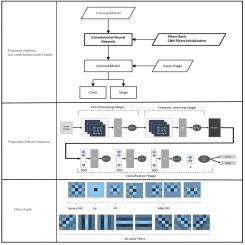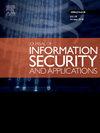利用空间富模型和二维 Gabor 滤波器增强基于卷积神经网络的空间域图像隐匿分析性能
摘要
基于图像的隐写分析问题吸引了众多研究人员,并提出了多种解决方案。基于深度学习的方法最有前途,因为它们能提供卓越的性能。基于卷积神经网络(CNN)的隐匿分析方法旨在提高检测率。与传统的 CNN 模型不同,基于 CNN 的隐写分析需要精心设计带有滤波器初始化的预处理层,以获得良好的性能。本文建立的 CNN 模型由两个卷积层和四个全连接层组成,前者用于预处理和特征提取,后者用于分类。预处理层使用一组由 SRM 和二维 Gabor 滤波器组成的高效滤波器组。我们使用公开流行的 BOSSbase_1.01 数据库和 Alask_v2 数据库中的灰度覆盖图像进行了实验,并考虑了两种不同的图像尺寸。结果表明,在三种著名的自适应空间域隐写术算法(S-UNIWARD、HUGO)中,所提出的 CNN 模型在其中两种算法中的表现优于许多最先进的研究,而在使用 512 × 512 图像的数据库时,所提出的 CNN 模型在(WOW)算法中的表现也很接近。另一方面,当使用原始图像大小(256 × 256)的数据库时,所提出的模型在三种算法中的表现优于许多最新研究。在使用图像尺寸为 256 和 S-UNIWARD 算法时,与之前最著名的模型(GBRAS-Net)相比,拟议模型的检测准确率提高了 13%,有效载荷为 0.2 和 0.4 bpp 的检测准确率提高了 4.25%。使用 HUGO 算法,与之前最知名的模型(GBRAS-Net)相比,拟议模型对 0.2 和 0.4 bpp 有效载荷的检测准确率分别提高了 7.4% 和 6.27%。在 WOW 算法中,所提出的模型略微落后于最佳模型(GBRAS-Net),但在有效载荷分别为 0.2 和 0.4 bpp 的情况下,能够获得接近的结果。在图像大小为 512 的情况下,对于 0.1、0.2、0.3、0.4 和 0.5 bpp 这五种有效载荷,与之前最知名的模型(H-CNN)相比,拟议模型的检测率分别比 S-UNIWARD 算法提高了 31.26%、21.51%、6.84%、4.22% 和 1.96%。此外,对于 0.1、0.2、0.3、0.4 和 0.5 bpp 五种有效载荷,与之前最知名的模型(H-CNN)相比,所提出的模型比 HUGO 算法分别提高了 27.60%、23.69%、12.66%、5.27% 和 6.23%的检测准确率。最后,与之前最知名的模型(H-CNN)相比,与 WOW 算法相比,所提出的模型对 0.1、0.2、0.3、0.4 和 0.5 bpp 五种有效载荷的检测率分别提高了 57.81%、46.84%、28.29%、20.34% 和 13.79%。

Image-based steganalysis problem has attracted many researchers, and several solutions have been proposed. Deep learning-based methods are the most promising as they provide superior performance. Convolutional Neural network(CNN) based steganalysis methods are designed to improve the detection rate. Unlike traditional CNN models, CNN-based steganalysis requires careful design of preprocessing layers with filter initialization to obtain a good performance. In this paper, we established a CNN model that consists of two convolution layers for preprocessing and feature extraction, and four fully connected layers for classification. The preprocessing layer uses a set of efficient filter banks consisting of SRM and 2D Gabor filters. We conducted experiments using grayscale cover images from a popular and publicly available BOSSbase_1.01 database and Alask_v2 database with consideration for two different image sizes. The results showed that the proposed CNN model outperforms many state-of-the-art studies in two out of three well-known adaptive spatial domain steganography algorithms (S-UNIWARD, HUGO) and provides a close result for (WOW) algorithm when using the database with 512 × 512 images. On the other hand, the proposed model outperforms many state-of-the-art studies in the three algorithms when using the database with the original image size (256 × 256). Using image size 256, and the S-UNIWARD algorithm, the proposed model improved the detection accuracy rate by 13%, and 4.25% payloads of 0.2 and 0.4 bpp respectively compared to the previously best-known model (GBRAS-Net). The proposed model achieved 7.4% and 6.27% improvement in the detection accuracy for both payloads 0.2 and 0.4 bpp respectively using the HUGO algorithm compared with the previously best-known model (GBRAS-Net). For the WOW algorithm, the proposed model is slightly behind the best model (GBRAS-Net) but was able to obtain a close result for both payloads of 0.2 and 0.4 bpp, respectively. Using an image size of 512, the proposed model achieved 31.26%, 21.51%, 6.84%, 4.22%, and 1.96% improvement in the detection rate for the five payloads 0.1, 0.2, 0.3, 0.4, and 0.5 bpp respectively over S-UNIWARD algorithm compared to the previously best-known model (H-CNN). In addition, the proposed model achieved 27.60%, 23.69%, 12.66%, 5.27%, and 6.23% improved detection accuracy for the five payloads 0.1, 0.2, 0.3, 0.4, and 0.5 bpp respectively over HUGO algorithm compared with the previously best-known model (H-CNN). Finally, the proposed model provided 57.81%, 46.84%, 28.29%, 20.34%, and 13.79% improvement in the detection rate for the five payloads 0.1, 0.2, 0.3, 0.4, and 0.5 bpp respectively over WOW algorithm compared to the previously best-known model (H-CNN).

 求助内容:
求助内容: 应助结果提醒方式:
应助结果提醒方式:


